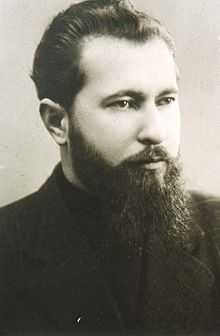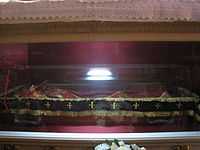Theodore Romzha
| Blessed Martyr Theodore Romzha | |
|---|---|
| Eparch of Mukacheve | |
 | |
| Church | Ruthenian Catholic Church |
| Diocese | Eparchy of Mukacheve |
| Appointed | 8 September 1944 |
| Term ended | 31 October 1947 |
| Predecessor | Oleksandr Stoika |
| Successor | vacant till 1983, then Ivan Semedi |
| Orders | |
| Ordination | 25 Dec 1936 (Priest) |
| Consecration | 24 Sept 1944 (Bishop) |
| Personal details | |
| Born |
14 April 1911 Velykyy Bychkiv, Austria-Hungary |
| Died |
31 October 1947 (aged 36) Uzhhorod, Ukrainian SSR |
| Sainthood | |
| Feast day | 31 October (martyrdom); 28 June (translation of relics) |
| Venerated in |
Greek Catholic Churches Roman Catholic Church |
| Title as Saint | Blessed Martyr |
| Beatified |
27 June 2001 Lviv by Pope John Paul II |
Blessed Theodore Romzha (Ukrainian: Теодор Ромжа, Hungarian: Tódor Romzsa, 1911–1947) was bishop of the Ruthenian Catholic Eparchy of Mukacheve from 1944 to 1947. Assassinated by Joseph Stalin's NKVD, he was beatified as a martyr by Pope John Paul II on June 27, 2001.
Early life
Theodore Romzha was born in the Subcarpathia region, Hungary, Austria-Hungary (in the Rusyn village Velykyy Bychkiv, now Ukraine) on April 14, 1911.[1] His father, Pavel Romzha, worked as an official of the railroad. His mother, the former Maria Semack, was a full-time homemaker. Like many ambitious families in the region, the Romzhas spoke the Hungarian language in the home. In the presence of others, however, they switched to their native Rusyn language to be polite.
After his graduation from the Gymnasium in Khust, Theodore left to study for the priesthood in Rome. He began as a seminarian at the Collegium Germanicum, but later switched to the Russicum.
Theodore was ordained a priest there by Bishop Aleksander Evreinov on Christmas Day, 1936 in the Basilica of St Mary Major. After completing his compulsory military service he served briefly as a pastor in several Transcarpathian parishes (part of Czechoslovakia since 1918) before being assigned as professor of philosophy at the Eparchial Seminary in Uzhhorod in 1939, now given back to Hungary.
Episcopate
These were difficult years for the Church in Subcarpathia as it experienced the invasions, later in 1938 by Hungary, one of Axis powers during the Second World War, then direct rule from Nazi Germany and lastly the Soviet Red Army.
On September 24, 1944, at the young age of 33, he was consecrated bishop and appointed apostolic administrator of the Eparchy of Mukacheve in the cathedral of Uzhorod by Bishop Miklós Dudás. He had immediately to face the soviet Red Army, which occupied the churches, assigned them to the Orthodox and arrested priests. Bishop Romzha refused in front of General Petrov to break with the Pope.[2]
His ministry to the faithful met with many roadblocks, but he managed to find a way around them. In particular he organized a celebration of the Feast of the Assumption with a participation of more that 80,000 pilgrims. This could not be tolerated by the Communist officials who now began looking to dispose of the young bishop.[2]
On October 27, 1947, on the way home from a parish visitation, Bishop Romzha's horse-drawn carriage was purposely rammed by a Soviet military truck and pushed off the side of the road. The soldiers, who were dressed as civilians, jumped from the truck and beat the bishop and his companions.[2] Soon after the brutal assault began a civilian truck came upon the scene and the assailants fled. Romzha and his companions were taken to Uzhhorod where they were hospitalized. Romzha was making good progress when, late on the night of October 31, the nuns who were nursing him were suddenly dismissed and new nurse was assigned to him by the regime.[2] A little after midnight Moscow Time, Romzha was found dead. The nurse had poisoned Romzha with an injection of curare provided by the head of NKVD Laboratory 1, Dr Grigory Mairanovsky.[3] According to research in Soviet archives by Yevgenia Albats, the Bishop's murder was ordered personally by Nikita Khrushchev.[4]
On November 4, 1947, a large crowd attended Romzha's funeral, despite Soviet efforts to shutdown and block public transportation. He was buried in the crypt of Holy Cross Cathedral in Uzhhorod.
The Ruthenian Catholic Church was relentlessly persecuted and in 1949 was officially suppressed.[5] All its properties were allocated to the Russian Orthodox Church.
Feast day and Relics

Romzha was beatified as a Martyr for the Faith by Pope John Paul II in Lviv on June 27, 2001 with November 1 assigned initially as his feast day. At the request of the Eparchy of Mukacheve, the Congregation for Oriental Churches transferred the feast day to October 31, effective 2009. Romzha died shortly after midnight November 1, according to Moscow Time, the Soviet-imposed time zone throughout Ukraine from 1930-1990; however, according to local time, Romzha died before midnight October 31.
In 1998, the relics of Blessed Romzha were found in a tomb in the crypt of Holy Cross Cathedral in Uzhhorod, and then transported to Budapest, Hungary for medical examination. On June 27–28, 2003 his relics were translated and carried in solemn procession to Uzhhorod, where they are enshrined in a side chapel at Holy Cross Cathedral. In commemoration of the event, a second feast day, the Translation of the Holy Relics of Blessed Theodore Romzha, is celebrated on June 28.
Notes
- ↑ David M. Cheney. "Bishop Bl. Theodore Romzha". Catholic-hierarchy. Retrieved 23 April 2011.
- ↑ 2.0 2.1 2.2 2.3 Mattei, Giampaolo (7 February 2001). "The Servant of God Bishop Theodore Romnza". L'Osservatore Romano, Weekly Edition in English (Rome): 8.
- ↑ Vadim J. Birstein. The Perversion Of Knowledge: The True Story of Soviet Science. Westview Press (2004) ISBN 0-8133-4280-5
- ↑ According to KGB archive, "By order of Khrushchev,... Romzha, head of the Greek Catholic Church, who actively resisted the incorporation of the Greek Catholic Church into Russian Orthodoxy, was eliminated", from Yevgenia Albats and Catherine A. Fitzpatrick. The State Within a State: The KGB and Its Hold on Russia - Past, Present, and Future, 1994. ISBN 0-374-18104-7, p. 33
- ↑ Paul Robert Magocsi. "Greek Catholic Eparchy of Mukachevo". World Academy of Rusyn Culture. Retrieved 22 April 2011.
Further reading
- Magocsi, Paul Robert and Ivan Pop (2005). Encyclopedia of Rusyn History and Culture. Toronto: University of Toronto Press. ISBN 0-8020-3566-3.
- Fr. Laslo Puskas (2002). Theodore Romzha: His Life - Times and Martyrdom. Fairfax, Virginia: ECPublications.
- Fr. Christoper Zugger, Finding a Hidden Church, Eastern Christian Publications, Fairfax, Virginia, 2009.
External links
|